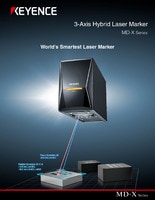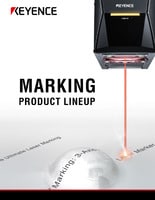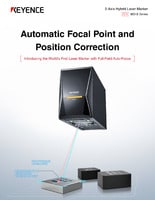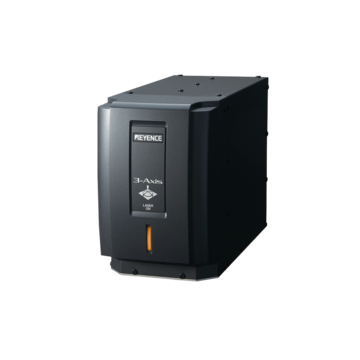Industrial Laser Marking Systems / Laser Markers
Fiber Laser vs. YVO4 Laser: Which One to Choose?
-
Tags:
- Laser Marking , Laser Engraving , Laser Etching
Anyone who has spent time around laser technology in manufacturing can tell you a fiber laser vs YVO4 laser comes with some apparent differences. Aside from their design and intended use case, hybrid compatibility can also deliver the best of both lasers into one task.
As you read through this article, explore the comparisons of fiber lasers vs YVO₄ lasers for a better understanding of their applications.
Overview of Fiber Lasers vs YVO4 Lasers
Although the terminology might throw you for a loop, the distinct differences are pretty brief. Both have varying laser technologies. The fiber design works with a single source, while hybrid laser markers combine two laser mediums for a combination of results.
A common comparison regarding hybrid design is between YVO4 lasers vs fiber lasers. However, it should be noted that these two laser types aren't always the same hybrid pairing used throughout the manufacturing industry.
We’re here to provide you with more details.
Reach out today!

Technical Comparison: Fiber vs. YVO4 Lasers
The YVO4 design utilizes yttrium orthovanadate crystal as the medium for the laser. This helps to enable peak power with an impressive amount of stability and efficacy.
YVO4 lasers can also be efficiently cooled. Above all else, the biggest selling point of YVO4 is that it doesn’t need the complex optical fiber components found in fiber lasers. However, there are some areas where the fiber design comes out on top, such as deep engraving.
The fiber design is a bit older and requires the assistance of rare earth elements such as erbium or ytterbium. These elements are doped into the core of optical fiber lasers, which generate laser emission.
The light source is provided by a semiconductor diode and passes through an optical fiber cable. Although fibers have seen multiple innovations over the years, many industry experts choose YVO4 due to its unique use cases, precision, and other unique design choices. While there are many differences between fiber, YVO4, and hybrid laser designs, focusing on the most important key design points is helpful.
Beam Quality and Efficiency
As with any laser design, both offer benefits with particular manufacturing use cases. Then again, when you compare YVO4 lasers and fiber lasers, there are evident differences in beam quality and overall efficiency.
- Fiber Lasers: Known to deliver consistent and high average power, the fiber design is optimal for deep engraving and extremely tight cycle times. The fiber design is also able to produce high output powers while maintaining a long service life.
- YVO4 Lasers: These are known for their high beam quality, high peak power, and overall versatility. The YVO4 design is able to mark a wider range of materials with more precision than the fiber design.
Now that the comparison in scalability, beam quality, and efficiency has been covered, it’s helpful to discuss how temperature plays an important role in both systems.
Thermal Management and Cooling Systems
Thermal and cooling system management is vital in all laser marking systems. Fiber lasers deliver efficient thermal management, and the same goes for YVO4 lasers. However, it should be noted that fiber lasers may be more sensitive to quick fluctuations in temperature.
With the fiber design, optical fibers can dissipate heat quite effectively at all times, which can help reduce costs and ongoing maintenance requirements. Cooling systems are used for all kinds of laser marking machines, but how they respond will vary depending on various factors.
Cost Analysis and Economic Considerations
When determining the scope of costs in manufacturing, it’s essential to consider the beginning, middle, and end. To expand on this further, initial costs, ongoing operational costs, and maintenance all play into the total financial commitment to a laser marker.
It’s also important to consider the shifting technology landscape in the debate about fiber design, hybrid lasers, and YVO4 designs. Sentiments towards these technologies can change with simple innovations. Nevertheless, each device currently has its own set of unique costs and economic factors.
Advantages and Limitations of Fiber Laser vs YVO4 Laser
Regardless of which laser marking system seems the best option, every laser design has advantages and limitations. Taking a comprehensive look at what fiber laser vs YVO4 laser offers is the best path to the right technology for your shop floor.
| Fiber Laser | YVO4 Laser | |
|---|---|---|
|
Advantages
|
Fiber Laser
|
YVO4 Laser
|
|
Disadvantages
|
Fiber Laser
|
YVO4 Laser
|
We understand it can be challenging to discern which laser marking machine is right for your needs. Although this does require considering many technical factors, we're here to assist you from an expert standpoint.
Discover more about this product.
Click here to book your demo.

Choosing Between Fiber and YVO4 Lasers
While many important angles influence the viability of a fiber or YVO4 laser in manufacturing, this is determined on a case-by-case basis. Each manufacturer has its own internal processes, production requirements, and other parameters that should be weighed against these devices' capabilities.
This is the best way to avoid unnecessary costs or wasted time and materials. Both laser styles are effective in modern manufacturing but excel only in the right applications.
The Expertise You Need
Now that you have a thorough understanding of the fiber and YVO₄ laser debate, it should be apparent which one is best for you. Between fiber, YVO4, and hybrid designs, manufacturers have everything they need to customize and optimize their production processes.
If you’d like more guidance on the topic, contact KEYENCE for all the direct expertise you need.
We’re here to provide you with more details.
Reach out today!

Related Downloads
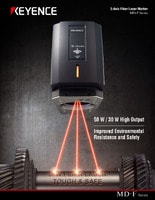
KEYENCE's MD-F Series offers unmatched functionality in a compact design.

